Volunteers Working Harder as COVID Heightens Need for Food
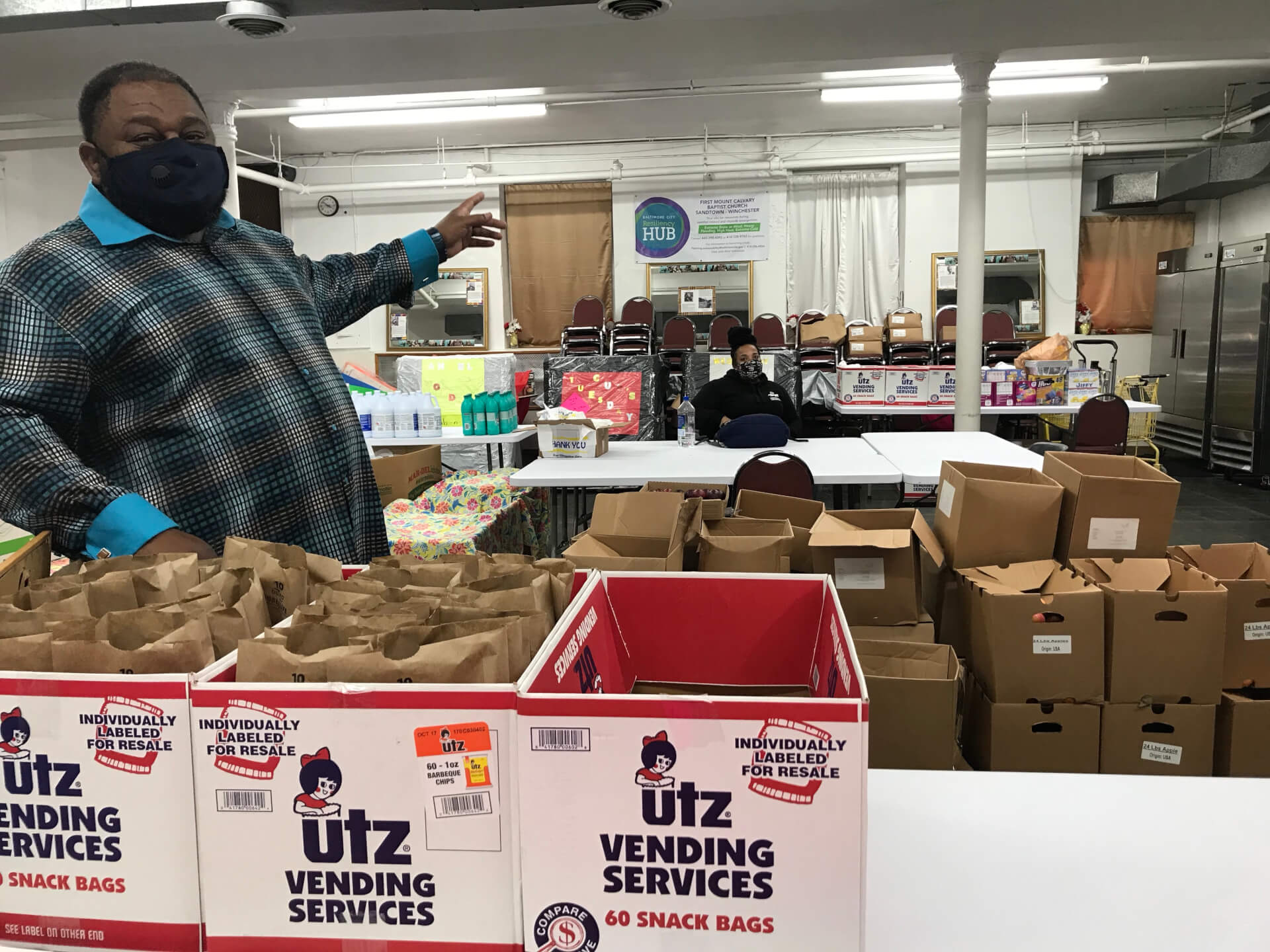
By Maria Trovato and Kamisha Walker
Outside Henderson-Hopkins School in East Baltimore every Friday, cars line up for blocks and people pushing carts walk up to get fresh food — more than 10,000 pounds of food every week, all gone in a few hours.
In West Baltimore, First Mount Calvary Baptist Church’s fellowship hall has been transformed into a food pantry, crammed with boxes of fruit, vegetables and fresh bread. By the church’s count, it fed more than 18,000 people between May and October.
Volunteers at Govans Presbyterian Church in North Baltimore spend several days a week at Soul Kitchen, preparing 50 to 100 hot meals to distribute outdoors on Sundays.
Food insecurity is far from a new issue in Baltimore, but the spread of COVID-19 — with schools shut and jobs lost — has intensified the problem. The Maryland Food Bank, a non-profit hunger-relief organization, saw its distribution rate increase by 96% over last year’s rate between March and October. It spent $17.5 million dollars on food in that period — a 371% increase compared to last year.
The number of Baltimoreans receiving aid through the Supplemental Nutrition Assistance Program rose 22% between the start of the pandemic in March and August, city officials said.
City government has expanded services, but communities have also taken it upon themselves to meet the growing need. Neighborhood leaders, many of whom have been feeding people for years, have found themselves working harder and giving away more food.
“There’s so many less opportunities for people to get a good meal,” said Carolyn Anewich, the spearhead of Soul Kitchen. “And there’s so many more people that need a good meal.”
Sandtown-Winchester
On the sidewalk outside First Mount Calvary Baptist Church on Saturdays, volunteers stack cardboard boxes filled with produce, from apples to squash, across a strip of folding tables. People arrive in cars or by foot to take food home. No one is turned away.
Before the pandemic, the church served hot meals from its soup kitchen once a week and distributed produce boxes once a month. Now, this Sandtown church hands out food six days a week — including lunches three times a week, hot meals once a week plus produce boxes on two days.
“The pandemic has created what everyone is calling a perfect storm, because now you have children who are out of school who would normally only eat when they’re in school,” said the church’s pastor, the Rev. Derrick DeWitt, who is also the president of Clergy United for the Transformation of Sandtown (CUTS). “You also have the lack of transportation or people afraid to use public transportation, and if they could afford to go grocery shopping, getting there is a problem.”
The church and its members have long been dedicated to providing food to the community, and before the pandemic, they relied completely on their own donations and grant money to do so, said Roxane Prettyman, the church’s outreach coordinator who does much of the cooking and distribution of food. With the ballooning need, the church partnered with CUTS and other nonprofit organizations to expand its services.
The church volunteers work with Food with a Focus, a fund created to provide food during the pandemic, to deliver food boxes to families of four every two weeks. A nearby urban farm, which the church helps run, provides produce for meals the church gives to older residents twice a week. The Angel Foundation and the Maryland Food Bank provide food to the church as well.
Other nonprofits and other churches help sponsor the work. Guinness Open Gate Brewery even donates bread.
How does the church pay for the rest? “We beg. A lot,” DeWitt said — for donations, for grant money, for sponsorships from wealthier suburban churches.
“I go to the suburban churches and I say, ‘You know you don’t have the problems we have, but you can help us,’ ” DeWitt said.
“Between our networking, our partners and contributions from our church members, we’re able to keep going.”
Kim McCoy Hopkins, who lives on the city’s west side, came to the church on a recent Saturday morning for food.
“It’s a blessing,” she said. “Times are extremely hard with this economy and people being laid off. It’s just a mess, trying to pay your mortgage, trying to pay your electric bill, trying to pay your water bill.”
McCoy Hopkins is a disabled veteran and has been unable to work since she left the service in 1999. She used to rely on family to make ends meet but can’t anymore. Four of her extended family members were laid off recently.
“I have had to make sacrifices– many sacrifices, like not being able to buy food,” McCoy Hopkins said.
Other community members use the church’s services to help those around them who have trouble getting out. Denise Reid, for example, has been doing this since 2012 and has carried food to older residents, in particular, during the pandemic.
And Reid does this work despite not having an easy time herself. In October, her nephew was killed. This month is also the anniversary of the death of Reid’s son, who was shot dead in 2006.
“Fortunately, with tragedy, comes triumph,” Reid. “We’ve been able to share the love and support of other families.”
Sandtown was in the headlines five years ago as the home of Freddie Gray, who died after being injured in police custody. Within all 74 square blocks of this predominantly Black neighborhood, there are 109 places to buy liquor and no grocery stores, DeWitt said. Sandtown, like many similar areas, historically has been neglected.
“These communities continue to be marginalized due to systemic racism over long periods of time, and I don’t think the government, whether it be local, state or federal government, has paid enough attention to what is the cause of these problems and how to fix it,” DeWitt said. “If you lay the poverty map over the redlining map, they’re almost identical. It’s a long period of systematic racism that has led us to where we are now.”
Only about half of residents 16 to 64 in Sandtown-Winchester were employed in 2018, according to census data collected by the Baltimore Neighborhood Indicators Alliance. The pandemic has only worsened unemployment in the area, as many residents work in the service industry and have been laid off, DeWitt said.
“You add that to the lack of access to healthcare, lack of access to food, lack of access to transportation, the fact that African Americans and people of color are more likely to have additional health problems,” DeWitt said. “It has created a real definite need for the increase in services as it relates to food.”
North Baltimore
For six years, Carolyn Anewich has been in charge of Soul Kitchen, a mission of the Govans Presbyterian Church that feeds people a hot gourmet meal once a week. Anewich not only runs the mission but is the head chef and publicist. She and her volunteers make it happen each week without pay.
Anewich says she knows what it is like to be hungry. In the past, she says, she had her own struggles. A Baltimore resident for 14 years, she’s seen more people in her community in need of food.
“There’s always been a need,” said Anewich. “I can’t imagine a time where there won’t be a need for what I do.”
When COVID-19 cases began to ramp up in March, Govans Presbyterian Church was forced to close.
During the first two weeks the church was shut, Anewich worried about the people who relied on her program. “People need food,” she recalls thinking. “We’ve got to do something.”
Her team began buying and packaging non-perishable foods to distribute. “Maybe SpaghettiOs aren’t the greatest thing to eat cold, but you can,” said Anewich.
Before COVID limited Soul Kitchen, Anewich worked with 20 or more volunteers a week, including students from Loyola University. The team could chop and dice vegetables for scores of meals in 30 minutes or less. Others prepared the church hall for dinner, organizing tables and chairs so that guests could mingle and build a sense of community.
“We always would have tablecloths and real glasses and real silverware and real plates. Basically, it’s like going to your mom’s or grandma’s for dinner.”
Soul Kitchen, Anewich says, is not only about feeding people but connecting her volunteers to the others in the community.
“It’s a way to get to know people you wouldn’t know otherwise.”
But the COVID-19 pandemic ended this weekly gathering. Now, Anewich works in her commercial kitchen with only one other person, standing at opposite sides of the kitchen. Chopping vegetables can take her hours. Because of the need for social distancing, no more than seven volunteers are allowed to help package and serve the food each week.
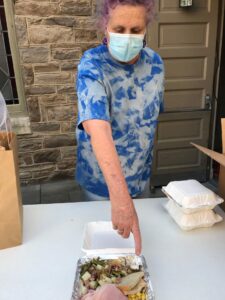
Carolyn Anewich cooks gourmet hot meals for guests at Govans Presbyterian Church in 2020 (Photo by Sandy Banisky/Capital News Service)
She’s been back in the kitchen since June, when other community programs began opening up. Now, guests come to a table outside the church hall to pick up hot meals packed in recyclable containers.
On a recent Sunday, the menu included beef curry with a cucumber salad, macaroni and cheese with balsamic brussels sprouts, and ham with a green-bean-and-potato salad. Each guest received three hot meals in one shopping bag — one for now, two for later.
“She is so determined to make sure that people eat, have a good hot meal every single week.” said Sandi McFadden, a community school coordinator in Govans.
“She does not take any shortcuts,” McFadden said. “She doesn’t use lesser quality food because she’s dealing with people who are downtrodden. If you could see the quality of what she serves to the guests, you would think you were coming out of a gourmet restaurant somewhere.”
Anewich spends $100 to $150 a week on meals for her community — the money budgeted by the church. That money is raised through individual donations or fundraisers, though because of COVID, the church was unable to hold its fundraiser this fall.
To make the most of the money, she buys food from grocery stores like Aldi, or Restaurant Depot, a wholesale food supplier. Trips to the grocery store happen once a week and take more than two-and-a-half hours before she gets back to unpack and store the goods in the church refrigerators.
“It’s pretty remarkable,” said the Rev. Tom Harris, the Govans Presbyterian pastor. “She’s really great at either finding deals or finding donations. People in the community have just been very generous and Carolyn’s nurtured a bunch of connections along the way.”
Anewich will often buy from other non-profit organizations, including the urban farm in Sandtown-Winchester that First Mount Calvary Baptist Church helps run.
“There’s so much cooperation between the nonprofits and the different groups,” Anewich added. “As things get better, I’m hoping that all these relationships can still be there.”
East Baltimore
Meal distribution at Henderson-Hopkins School started as a stopgap when the COVID-19 pandemic shut down schools, leaving children without access to regular meals. Within weeks, the staff transformed the program to feed the rest of the East Baltimore community as well.
Henderson-Hopkins opened eight years ago, the first new public school to come to the East Baltimore area in two decades. The school, a partnership of Johns Hopkins University and the City of Baltimore, teaches pupils in grades pre-K through eight, with African American children making up 98% of the student body.
In March, after pandemic-forced closings, Baltimore City Public Schools designated meal sites across the city to allow pupils to pick up the breakfast, lunch, snack and dinner they would have had in school. Henderson-Hopkins was one of them.
Peter Kannam, the Henderson-Hopkins principal, decided to go further, expanding the program beyond the children to the rest of their families.
“One thing that I noticed when I became the principal is food insecurity is a real issue,” Kannam said. “There is not a grocery store within walking distance. It’s a food desert. Where do people get food?”
The rise in hunger caused by the pandemic inspired Henderson-Hopkins to build partnerships with organizations and businesses such as the Maryland Food Bank and Coastal Sunbelt Produce. These relationships, as well as a $30,000 donation from Johns Hopkins University, allowed Kannam and his team to get groceries to the school’s families and others in the area.
About $5,000 a week brought the school team 10,000 pounds of food — fresh fruits, vegetables and canned goods all ready to be packaged and distributed by staff and volunteers on Fridays.
“Fascinating things happened when we started doing this,” said Kannam.
He told the school families on social media that groceries would be available once a week. But word spread through the community. Cars pulled up one after the other, the line going for blocks, and people waited on the sidewalk.
“Within an hour, it was all gone,” he said.
The school was feeding about 250 to 300 families each week. But he was curious about how many of them were families of Henderson-Hopkins.
“I started tracking it and it was about 30 families that were coming out of 300.” Kannam said. “What I realized immediately…we weren’t even advertising to the broader community but there was such a demand and need.”
To be sure that families of Henderson-Hopkins pupils were receiving food, he offered them delivery. A hundred families signed up, he said.
Maria Delcid, a stay-at-home mother of three, walks to Henderson-Hopkins and every week to pick up food for her children and family. Her children, 1, 5 and 12, are all pupils at the school.
“The pandemic has affected our family economically. Sometimes my husband works and sometimes he doesn’t,” Delcid said.
“It’s an easy process to get the food,” she said, “because the people that work there already know me, so they always have my box set aside for me when I go.”
“The work that they’re doing here…I think it’s tremendous,” said Bea Cook, who heard about the program through word of mouth. “They’re feeding people that really need to be eating.”
To keep the program going, the school team has had to raise funds by seeking grants or individual donations. To date, they’ve managed to raise more than $100,000 — allowing them to distribute over 319,000 pounds of food to more than 9,800 families.
They continue to look for money wherever they can.
“When we see a grant that can be used for food distribution, we apply for it,” said Assistant Principal J.D. Merrill. “It is my sense that there were more resources available for food at the beginning of the pandemic than there are now, which is challenging because the need remains so urgent.”
“I’m just super proud we started doing this in March,” Kannam said. “We’re really proud that we’ve kept the food distribution going.”
Baltimore City
Seeing an overwhelming need and increase in SNAP requests, the city developed an emergency food strategy that includes distributing food boxes and meals at sites all over the city.
This effort involves city agencies, the Maryland Food Bank, companies such as Coastal Sunbelt Produce and Common Market, a regional food distributor, and community and nonprofit organizations.
Between April and October, the city provided about 9 million pounds of food boxes and 5.7 million meals at over 400 sites and through deliveries, according to city figures.
The Maryland Food Bank has been accepting donations from different companies. Smithfield Foods, for example, has donated more than 450,000 pounds of protein to the Maryland Food Bank between March and November. Jonathan Toms, Smithfield’s charitable initiatives manager, said the crises caused by the pandemic led them to give “above and beyond” what they normally donate.
The city is also distributing more food to Baltimore’s older adults, who are especially vulnerable to the virus and often have no way of getting food on their own. The health department and its partners have expanded their services to provide 1.7 million meals to this population between April and October.
While the city has been able to cover most costs by using federal funding from the CARES Act, the stimulus bill passed by Congress in March, that funding is set to expire this month, said James Macgill, who oversees food services for older adults at the Baltimore City Health Department Division of Aging.
“The pandemic has heightened that this issue was there all along, and we need a broader approach,” Macgill said. “If there’s no additional funding that comes to us, we’re going to have to make some very difficult choices, as to who gets prioritized and who continues to receive meals.”

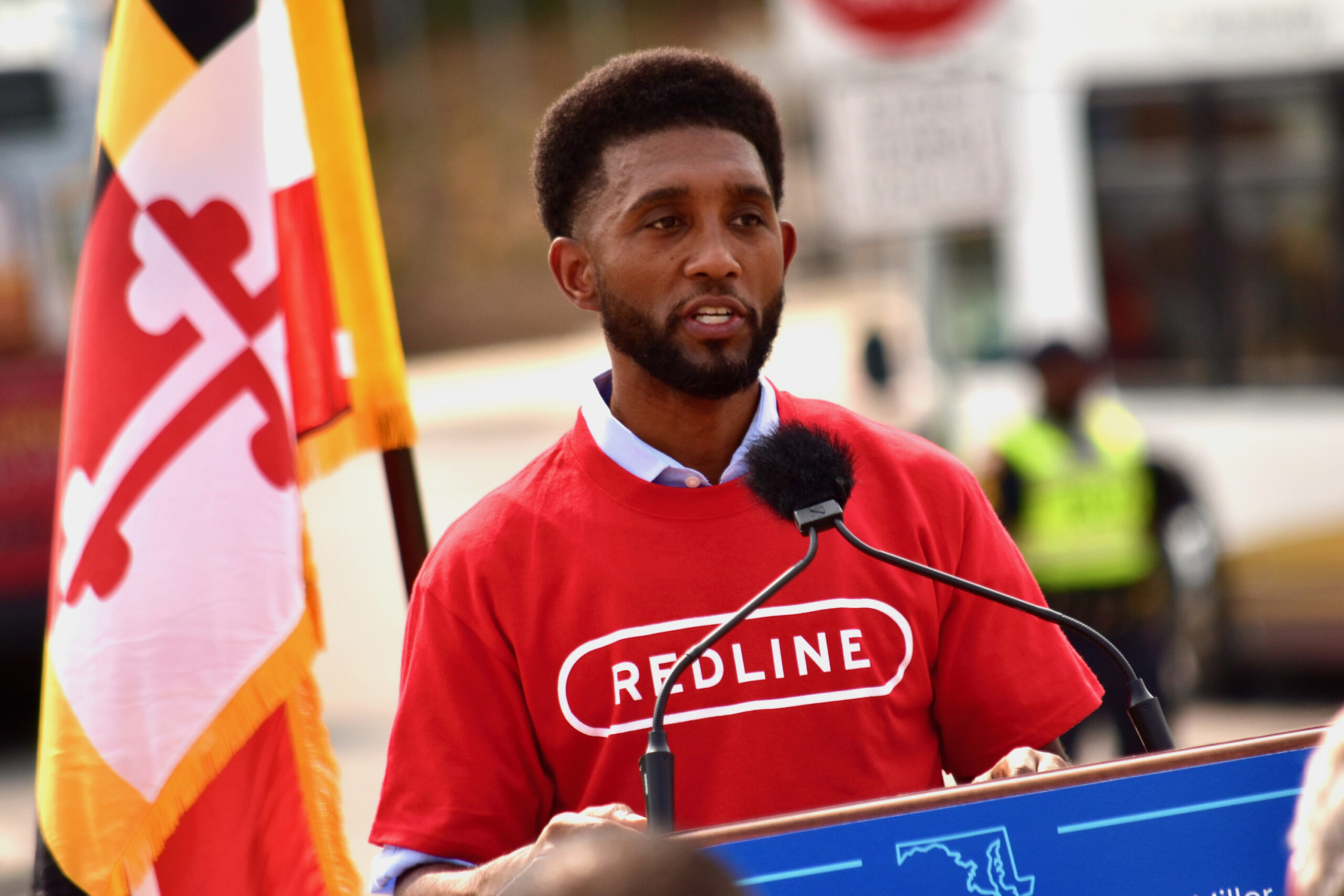
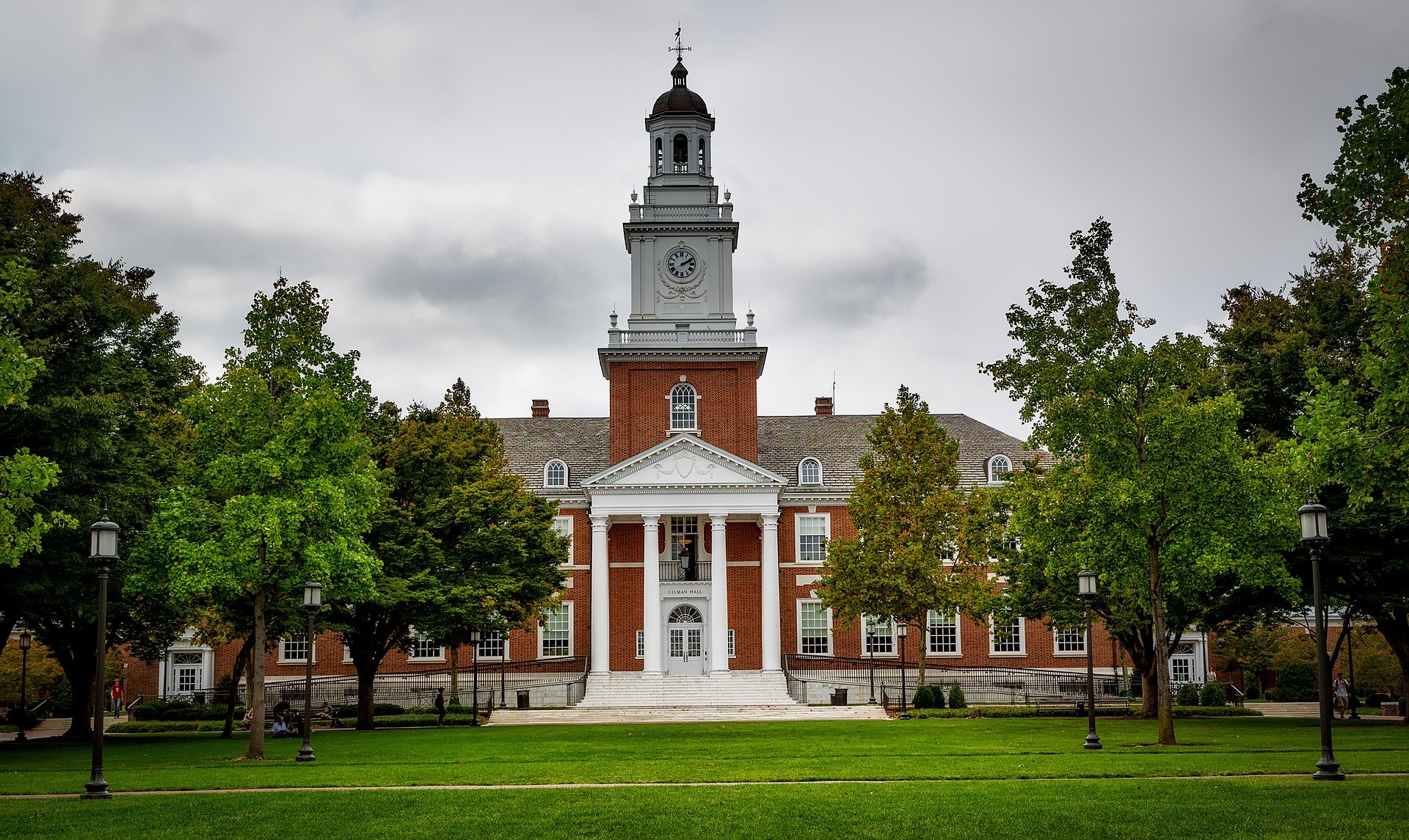
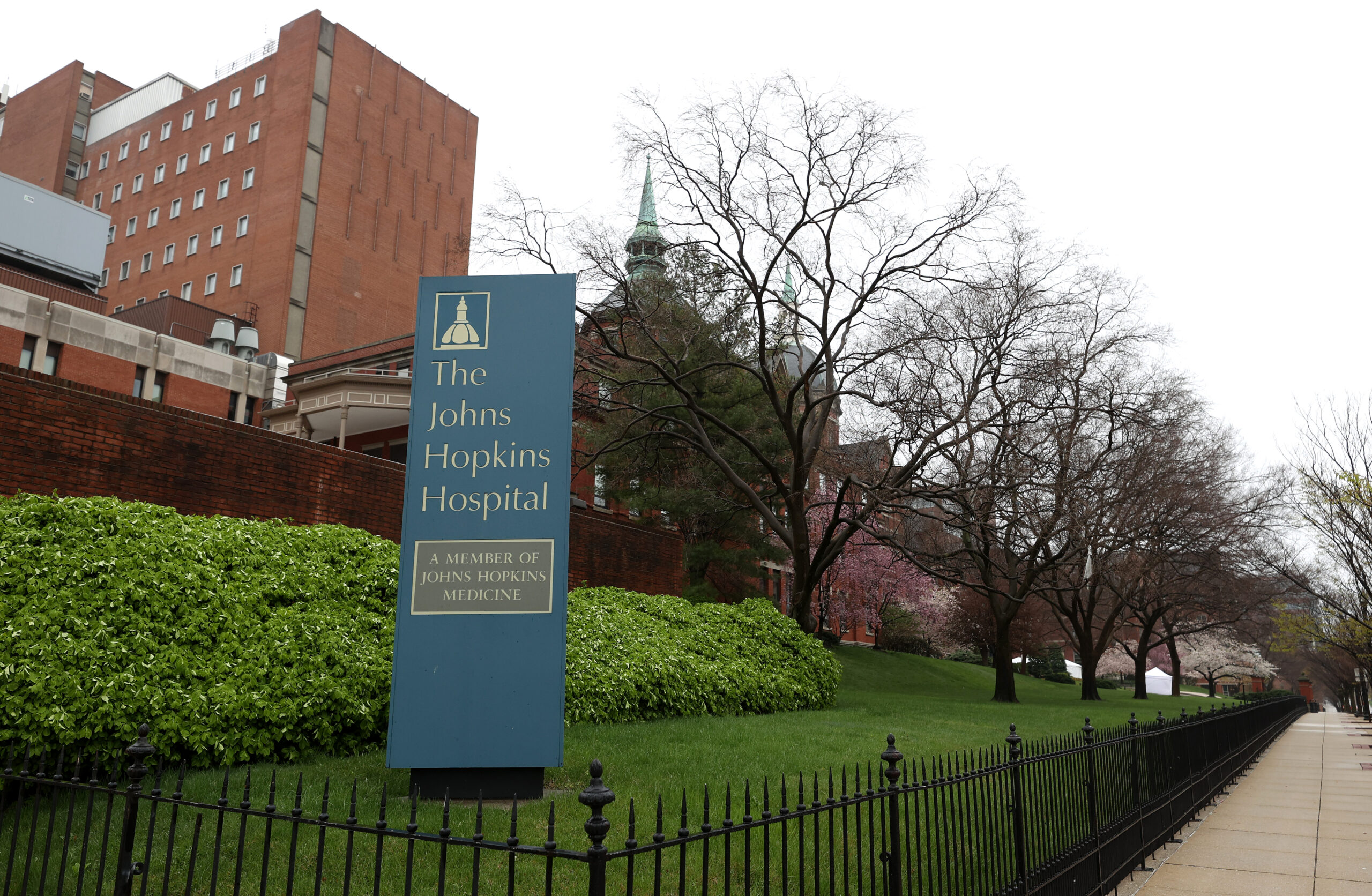
 Creative Commons Attribution
Creative Commons Attribution